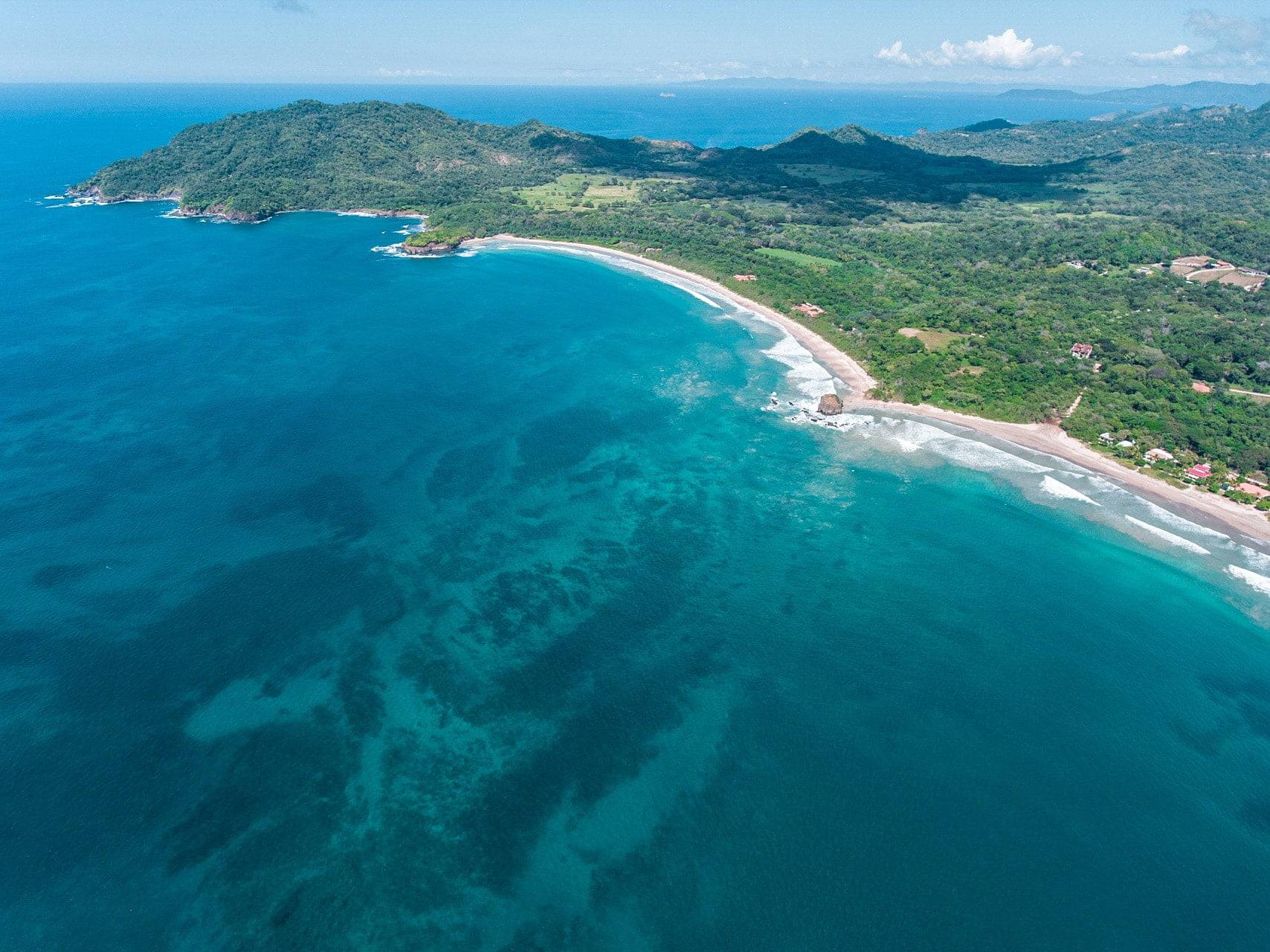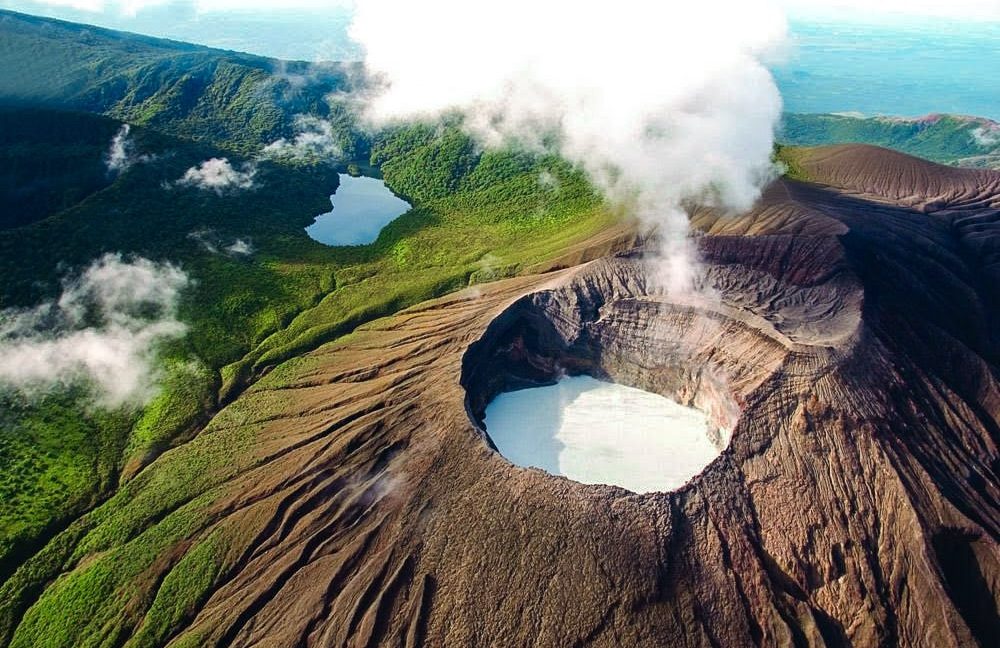Living in Tamarindo, you’ll soon find yourself exploring beaches and waterfalls, tropical dry forest and active volcanoes. In other words, all manner of ecological riches and diverse landscapes, many of which are ensconced, conserved, and protected within breathtaking Costa Rica national parks.
And again, living in Tamarindo, you’re going to be close to many of them. Seven, in fact. Seven glorious, vastly different, incredibly wild national parks that introduce you to the riches and wonders that weave vibrance and life into the tapestry of Costa Rican life.
From nearest to farthest, seven national parks within a 2.5-hour drive of Tamarindo:
Las Baulas National Marine Park

Beautiful Playa Grande is located within Las Baulas National Marine Park
Distance from Tamarindo: 1 kms (just across the river mouth)
Driving Time: Take the estuary ferry!
Living in Tamarindo, we (including you!) are so lucky to have one of the most incredible Costa Rica national parks as our own backyard.
We are, of course, talking about el Parque Nacional Marino Las Baulas, often mistranslated at Marino Las Baulas National Park. In point of fact, it’s Las Bualas National Marine Park, so named for the leatherback sea turtles (las baulas) that famously nest in the park’s expansive 43,240+ acres (175 km2), of which only 1,900 acres (7.7 km2) are on land!
The rest of the park’s acreage resides in the Pacific Ocean, where nesting sea turtles return each year. And, indeed, Las Baulas is one of the world’s largest leatherback nesting sites – a fact made all the more impressive, considering that leatherbacks are an endangered species, meaning their populations are on the decline.
Las Baulas National Marine Park and Costa Rican conservation efforts are on the front line of preserving this important habitat – and an entire species! Speaking of, the park also protects the Tamarindo estuary and its precious mangrove forests, which house vast biodiversity, including several species who live only in this habitat.
All this, right in your own backyard… Ask us again why we live in Costa Rica!
Diriá National Park
Distance from Tamarindo: 50 kms
Driving Time: 1 hour, 20 minutes
Shhh! This is one of those when you know, you know kind of moments but… Have you heard of (or even visited) Diriá National Park? It’s something of a best-kept-secret, as far as Costa Rica national parks go.
And honestly, we can’t quite put our finger on why. Home to vast biodiversity and one of the world’s rarest ecosystems, Diriá (pronounced deer-ee-AH, with the emphasis on the AH) is home to tropical dry forest.
While rainforests get much of the pomp and circumstance, the tropical dry forest is the most endangered major tropical ecosystem in the world. Home to flora and fauna that can live nowhere but here, tropical dry forests are now on the decline.
Consider that, 500 years ago, this rare forest once covered 550,000 square kilometers (about 212,356 square miles) of the Americas, today just 480 square kilometers – that’s 0.09% of the original acreage – enjoys conservation status. That’s in the entire Americas, not just Costa Rica. And Diriá National Park (along with Rincón de la Vieja National Park, Guanacaste National Park, and Santa Rosa National Park) protects some of those precious few square kilometers.
Of course, that’s not all you can see here! The park’s higher elevations also house primary forest and, specifically, premontane rainforest. This virgin forest has never been cut, changed, or otherwise felled – nearly irreplicable circumstances, as far as Mother Nature is concerned. And that means that you’ll find here another of the world’s rarest ecosystems, homes to 134+ bird species, thick tree canopies, and species and micro-habitats you likely won’t encounter anywhere else.
Barra Honda National Park
Distance from Tamarindo: 69 kms
Driving Time: 1 hour, 35 minutes
Did you know that you could go cave spelunking, in real life, this close to your home in Tamarindo? We did! And it’s exciting.
Welcome to Barra Honda National Park, one of those rare and raw natural experiences that many of us only read about. But, it’s true: One of the most unique Costa Rica national parks, this nearby gem was formed by shifting tectonic plates that, long ago, forced soft limestone and ancient coral reefs toward the earth’s surface.
From there, weather, rain, and erosion stepped into their roles in forming Barra Honda’s vast subterranean cavern system. It only took 70 million years, but in 1971, Costa Rica declared Barra Honda a national park and speleologists began their explorations and studies.
To date, less than half of the park’s caves (currently: 19 of 42) have been studied, revealing treasures in the form of stalactite and stalagmite formations, pre-Columbian artifacts, and subterranean wildlife. If you want to join in the fun, we strongly recommend booking a guided cavern tour, which takes spelunkers into Barra Honda’s famous cave trio, known as Terciopelo (Fer de Lance), Santa Ana, and Trap caverns.
Palo Verde National Park
Distance from Tamarindo: 86 kms
Driving Time: 2 hours
Skipping from one superlative to the next (that’s just how Guanacaste rolls!), welcome to Palo Verde National Park, a birdwatching paradise, even among our biodiverse Costa Rica national parks!
A vital watershed for all our major regional rivers, Palo Verde – not coincidentally, Spanish for “green stick,” for all its verdant landscapes) – is a vital and critically important wetland sanctuary. And considering that Guanacaste is Costa Rica’s driest province, the park’s ecosystem and importance take on an even more essential role…
Located at the mouth of the Tempisque River, this 45,500-acre park encompasses an incredible 15 diverse habitats – from rolling pastureland to evergreen (yes, really) forests. That said, most visitors go for the all-important wetlands, which extend to marshes, salt ponds, rivers, and mangroves that provide refuge for up to 250,000 birds at one time.
Yes – a quarter of a million birds! Because Palo Verde National Park is a beloved and celebrated birdwatching hotspot. It’s not only home to big resident and migratory populations, but also the largest concentration of shorebirds and waterfowl in Central America. Keep your eyes peeled fr herons, egrets, grebes, ibis, and even the flamingo-like roseate spoonbill!
Not much of a birdwatcher? Fear not. In addition to the park’s drenched landscapes, Palo Verde is also home to a wide variety of mammal and reptile life, including curious white-faced monkeys, foraging coatimundis, floating crocodiles, hooting howler monkeys, inquiring armadillos, and Costa Rica’s largest population of jaguarondi, a small wildcat species (Herpailurus yagouaroundi).
Rincón de la Vieja National Park

Rincón de la Vieja National Park is home to its namesake (and active!) volcano
Distance from Tamarindo: 105 kms
Driving Time: 2 hours, 25 minutes
Legend tells that Rincón de la Vieja – in Spanish, the [Old] Woman’s Corner – is named for a long-ago princess whose father through her lover into the volcano’s crater. Heartbroken over her lost love, she retreated to the mountaintop where she later developed healing powers.
Today, the princess’s restorative spirit resides at the center of Rincón de la Vieja National Park and its eponymous (and active!) Rincón de la Vieja Volcano: The one-million-year-old fire mountain continues to spit and hiss, stoking its hidden fires to fuel the park’s hot springs, which are said to have healing powers. Soak away your aches and pains as you luxuriate in the heat of an active volcano!
Of course, there’s a lot more to this incredible park than relaxation. And, truth be told, this is one of our favorite Costa Rica national parks. And we make that statement lightly. This one is special.
Home to 35,336 acres, 32 rivers and streams, tropical dry forest and cloud forest, and 9 separate but contiguous volcanic craters – together, the largest volcano (of 5) in the Guanacaste Mountain Range – this park is just getting started on the impressive accolades.
That’s because your visit here begins at the Las Pailas Sector (one of two sections of the park), where you’ll explore truly breathtaking and adrenaline-inducing sights, including a mini-volcano, boiling mud pots (las pailas, of course!), hot springs (these ones are not for soaking!), steaming fumaroles, seasonal waterfalls, and more.
“Astonishing” is the only word that even begins to come close…
Guanacaste National Park
Distance from Tamarindo: 110 kms
Driving Time: 2 hours, 10 minutes
If you love a great, feel-good story, then you’ll appreciate the genesis of Guanacaste National Park: It was created in 1989 as a sign of hope and habitat bridge between the high-altitude cloud forests of Cacao Volcano and Orosi Volcano.
Indeed, Guanacaste National Park provides critical habitat for Costa Rica’s big cats – namely, pumas/mountain lions and jaguars. Both have a large, single-cat range (with little to no overlap), creating a need for this requisite biological corridor, roaming ground, and home to an incredible variety of resident and migratory bird species.
Its beginnings provide even more fodder for all the feels: Once upon a time, Dr. Daniel Janzen had a vision. The evolutionary ecologist and conservationist set out to show the world “how to grow a national park.” Not surprisingly, he chose Costa Rica, where cattle ranchers were eager to sell of their land (due to low beef prices).
Three decades later, and that land has blossomed into one of the most inspiring and inspired Costa Rica national parks. The once-pastureland is now regenerating faster than predicted and a biological corridor has, indeed, formed. Guanacaste National Park has come alive again.
If you’re looking to tick off a special, bucket-list experience, know that the park’s lowland dry forests rise into rainforest and cloud forest, where you can literally hike from one side of the world to another: That’s right, you can cross the Continental Divide – the passage from the Pacific to the Caribbean.
Santa Rosa National Park
Distance from Tamarindo: 115 kms
Driving Time: 2 hours, 15 minutes
The final national park to make our near-drive list, Santa Rosa National Park is both an exploration of nature and a dive into Costa Rican history.
Let’s start with the former: Santa Rosa is jaw-dropping in its biodiversity. Home to everything from beaches that protect nesting sea turtles to rare tropical dry forest, this park traverses landscapes that house 115 mammal species, 250 bird species, and a startling 4,000 butterfly species.
And yet, that’s not the primary draw! In point of fact, Santa Rosa is best known not for nature but for its role in Costa Rica’s history. For this nation, now famous for abolishing its army, once won a pivotal battle, right here, at the site of the park’s La Casona (the “Big House” or “Main House”).
In the mid-1800s, the filibusters had arrived in Costa Rica. Led by William Walker, a U.S. citizen, the filibusters sourced their funds and charged into the Americas, hoping to annex the newly independent nations.
Then, during the Battle of Santa Rosa (March 20, 1856), a small Costa Rican force defeated Walker’s filibusters. Key to their success: Costa Rican national hero, Juan Santamaría – a young drummer boy who died while creating a critical diversion for the filibusters. Over 165 years later, his sacrifice remains near and dear to Costa Rican hearts.
And if that’s not enough, the park later witnessed two more historic events: In 1919, when invaders attempted to overthrow the Tinoco Granados government, and in 1966, when Costa Ricans drove out an invading Nicaraguan army. The burned-out tank from that final altercation remains at the park, joining a still-standing La Casona and a small museum. Talk about a crash course in local history!
Live Here, See This: Will You Call Tamarindo Home?
Calling Tamarindo and Costa Rica home opens up a whole new world of possibilities to see, experience, and explore.
Helping you get from today to tomorrow – from dreams to setting down roots in paradise – just happens to be one of our fortes. At Blue Water Properties, we are happy to help you in any way we can. We can talk about locations and costs of living, schools and lifestyle. We can refer you to residency attorneys or other sources of information, and share our own experiences and lessons learned.
As a company and as people, we thrive on relationships and promise the fastest communication and best services in the industry. And that begins with lots of information. We are happy to answer your questions and point you in the right direction, even if you’re only in the beginning phases of planning your future move.
We’re proud to offer some of the best Costa Rica real estate, from condos and homes to land and businesses for sale. So, go ahead – try us. Give us a chance to show off our expertise – and wow you with the possibilities! We look forward to it.


